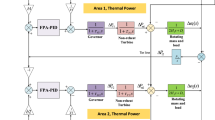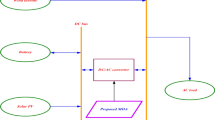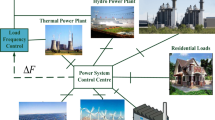Abstract
In order to realize the coordinated design of multiple flexible AC transmission systems (FACTS) devices in the wind–PV–thermal-bundled (WPTB) power transmission system to suppress the low-frequency oscillation (LFO) of the system, in this paper, the static synchronous compensator (STATCOM) and the static synchronous series compensator (SSSC) with additional power oscillation damping controller (PODC) are designed based on the tie line transmission power signal to enhance the improvement effect of FACTS devices on system stability. The objective function is constructed by considering the transient voltage stability of the WPTB power transmission system, the real part of the eigenvalues and damping level of the LFO modes. And the coordinated and optimized design of power system stabilizer (PSS), SSSC-PODC and STATCOM-PODC is performed by the hybrid particle swarm optimization algorithm and genetic algorithm (PSO-GA) and pattern analysis theory of LFO. Finally, it is verified that the design can give full play to the effect of different controllers and significantly improve the damping ratio of the oscillation mode between regions through the simulation under the output variation of the new energy unit and the transmission power variation of the liaison line. When the fault occurs, the amplitude of oscillation and the time required to recover stability of the system decrease obviously, which enhances the dynamic stability of the system.













Similar content being viewed by others
Data availability
The datasets used or analyzed during the current study are available from the corresponding author on reasonable request.
References
He LC, Lu ZG, Geng LJ, Zhang JF, Li XP, Guo XQ (2020) Environmental economic dispatch of integrated regional energy system considering integrated demand response. Int J Electr Power Energy Syst 116:105525. https://doi.org/10.1016/j.ijepes.2019.105525
Khasanov M, Kamel S, Rahmann C, Hasanien HM, Al-Durra A (2021) Optimal distributed generation and battery energy storage units integration in distribution systems considering power generation uncertainty. IET Gener Transm Distrib 15(24):3400–3422. https://doi.org/10.1049/gtd2.12230
Liu SY, Lin ZZ, Jiang YC, Zhang TH, Yang L, Tan WT, Lu F (2022) Modelling and discussion on emission reduction transformation path of China’s electric power industry under “double carbon” goal. Heliyon 8(9):e10497. https://doi.org/10.1016/j.heliyon.2022.e10497
Pei W, Zhang X, Deng W, Tang CH, Yao LZ (2022) Review of operational control strategy for DC microgrids with electric-hydrogen hybrid storage systems. CSEE J Power Energy Syst 8(2):329–346
He P, Wu XX, Li CS, Zheng MM, Li Z (2020) Improvement of damping characteristics and index evaluation of a wind-PV-thermal-bundled power transmission system by combining PSS and SSSC. Archiv Electr Eng. https://doi.org/10.24425/aee.2020.133927
Dong J, Dou ZH, Si SQ, Wang ZC, Liu LX (2022) Optimization of capacity configuration of wind–solar–diesel–storage using improved sparrow search algorithm. J Electr Eng Technol 17(1):1–14. https://doi.org/10.1007/s42835-021-00840-3
Ranamuka D, Muttaqi KM, Sutanto D (2019) Flexible AC power flow control in distribution systems by coordinated control of distributed solar-PV and battery energy storage units. IEEE Trans Sustain Energy 11(4):2054–2062. https://doi.org/10.1109/TSTE.2019.2935479
Nguyen N, Bera A, Mitra J (2018) Energy storage to improve reliability of wind integrated systems under frequency security constraint. IEEE Trans Ind Appl 54(5):4039–4047. https://doi.org/10.1109/TIA.2018.2838558
Ying J, Yuan XM, Hu JB, He W (2018) Impact of inertia control of DFIG-based WT on electromechanical oscillation damping of SG. IEEE Trans Power Syst 33(3):3450–3459. https://doi.org/10.1109/TPWRS.2018.2801283
Zhou X, Usman M, He P et al (2021) Parameter design of governor power system stabilizer to suppress ultra-low-frequency oscillations based on phase compensation. Electr Eng 103:685–696. https://doi.org/10.1007/s00202-020-01101-8
Gururaja Rao HV, Prabhu N, Mala RC (2020) Wavelet transform-based protection of transmission line incorporating SSSC with energy storage device. Electr Eng 102:1593–1604. https://doi.org/10.1007/s00202-020-00978-9
He JH, Chen KA, Li M, Luo YP, Liang CG, Xu Y (2020) Review of protection and fault handling for a flexible DC grid. Protect Control of Mod Power Syst 5(1):1–15. https://doi.org/10.1186/s41601-020-00157-9
Gurung S, Jurado F, Naetiladdanon S et al (2019) Optimized tuning of power oscillation damping controllers using probabilistic approach to enhance small-signal stability considering stochastic time delay. Electr Eng 101:969–982. https://doi.org/10.1007/s00202-019-00833-6
He P, Qi P, Ji YQ, Li Z (2021) Dynamic interactions stability analysis of hybrid renewable energy system with SSSC. Archiv Electri Eng 70(2):445–462. https://doi.org/10.24425/aee.2021.136995
Dey P, Mitra S, Bhattacharya A, Das P (2019) Comparative study of the effects of SVC and TCSC on the small signal stability of a power system with renewables. J Renew Sustain Energy 11(3):033305. https://doi.org/10.1063/1.5085066
Sadiq AA, Buhari M, Adamu SS, Musa H (2020) Coordination of multi-type FACTS for available transfer capability enhancement using PI-PSO. IET Gener Transm Distrib 14(21):4866–4877. https://doi.org/10.1049/iet-gtd.2020.0886
Deng JC, Li C, Zhang XP (2015) Coordinated design of multiple robust FACTS damping controllers: a BMI-based sequential approach with multi-model systems. IEEE Trans Power Syst 30(6):3150–3159. https://doi.org/10.1109/TPWRS.2015.2392153
He P, Shen RJ, Wen FS, Pan Q (2021) Coordinated optimization of parameters of PSS and UPFC-PODCs to improve small-signal stability of a power system with renewable energy generation. J Energy Eng 147(2):04020089. https://doi.org/10.1061/(ASCE)EY.1943-7897.0000737
Zhang GZ, Hu WH, Cao D, Yi JB, Huang Q, Liu Z, Blaabjerg F (2020) A data-driven approach for designing STATCOM additional damping controller for wind farms. Int J Electr Power Energy Syst 117:105620. https://doi.org/10.1016/j.ijepes.2019.105620
Bhukya J, Mahajan V (2021) Parameter tuning of PSS and STATCOM controllers using genetic algorithm for improvement of small-signal and transient stability of power systems with wind power. Int Trans Electr Energy Syst 31(7):e12912. https://doi.org/10.1002/2050-7038.12912
He P, Wen FS, Ledwich G, Xue YS (2016) An investigation on interarea mode oscillations of interconnected power systems with integrated wind farms. Int J Electr Power Energy Syst 78:148–157. https://doi.org/10.1016/j.ijepes.2015.11.052
Slootweg JG, Kling WL (2003) The impact of large scale wind power generation on power system oscillations. Electric Power Syst Res 67(1):9–20. https://doi.org/10.1016/S0378-7796(03)00089-0
Yu GZ, Lin T, Zhang JN, Tian Y, Yang X (2019) Coordination of PSS and FACTS damping controllers to improve small signal stability of large-scale power systems. CSEE J Power Energy Syst 5(4):507–514. https://doi.org/10.17775/CSEEJPES.2018.00530
Haque MH (2004) Improvement of first swing stability limit by utilizing full benefit of shunt FACTS devices. IEEE Trans Power Syst 19(4):1894–1902. https://doi.org/10.1109/TPWRS.2004.836243
Karaagac U, Kocar I, Mahseredjian J, Cai LJ, Javid Z (2021) STATCOM integration into a DFIG-based wind park for reactive power compensation and its impact on wind park high voltage ride-through capability. Electric Power Syst Res 199:107368. https://doi.org/10.1016/j.epsr.2021.107368
Hasanvand H, Arvan MR, Mozafari B (2016) Coordinated design of PSS and TCSC to mitigate interarea oscillations. Int J Electr Power Energy Syst 78:194–206. https://doi.org/10.1016/j.ijepes.2015.11.097
Benabid R, Boudour M, Abido MA (2012) Development of a new power injection model with embedded multi-control functions for static synchronous series compensator. IET Gener Transm Distrib 6(7):680–692. https://doi.org/10.1049/iet-gtd.2011.0296
Pradhan AC, Lehn PW (2005) Frequency-domain analysis of the static synchronous series compensator. IEEE Trans Power Deliv 21(1):440–449. https://doi.org/10.1109/TPWRD.2005.852311
He P, Wen FS, Ledwich G, Xue YS, Wang KW (2013) Effects of various power system stabilizers on improving power system dynamic performance. Int J Electr Power Energy Syst 46:175–183. https://doi.org/10.1016/j.ijepes.2012.10.026
Kundur P, Balu NJ, Lauby MG (1994) Power system stability and control. McGraw-Hill, New York, pp 398–480
Funding
This work is supported by the National Natural Science Foundation of China (NSFC) (No. 52377125) and the Scientific and Technological Research Foundation of Henan Province (No. 222102320198). The authors have no relevant financial or non-financial interests to disclose. All authors certify that they have no affiliations with or involvement in any organization or entity with any financial interest or non-financial interest in the subject matter or materials discussed in this manuscript. The authors have no financial or proprietary interests in any material discussed in this article. Preprint statement: This manuscript has been preprinted [https://doi.org/10.22541/au.166682234.41889369/v1].
Author information
Authors and Affiliations
Contributions
PH and ZP developed the idea of the study, analyzed the data and wrote the paper. JF completed mathematical modeling. YT and MW designed and polished the figures.
Corresponding author
Ethics declarations
Conflict of interest
The authors declare that they have no known competing financial interests or personal relationships that could have appeared to influence the work reported in this paper.
Additional information
Publisher's Note
Springer Nature remains neutral with regard to jurisdictional claims in published maps and institutional affiliations.
Rights and permissions
Springer Nature or its licensor (e.g. a society or other partner) holds exclusive rights to this article under a publishing agreement with the author(s) or other rightsholder(s); author self-archiving of the accepted manuscript version of this article is solely governed by the terms of such publishing agreement and applicable law.
About this article
Cite this article
He, P., Pan, Z., Fan, J. et al. Coordinated design of PSS and multiple FACTS devices based on the PSO-GA algorithm to improve the stability of wind–PV–thermal-bundled power system. Electr Eng 106, 2143–2157 (2024). https://doi.org/10.1007/s00202-023-02055-3
Received:
Accepted:
Published:
Issue Date:
DOI: https://doi.org/10.1007/s00202-023-02055-3




